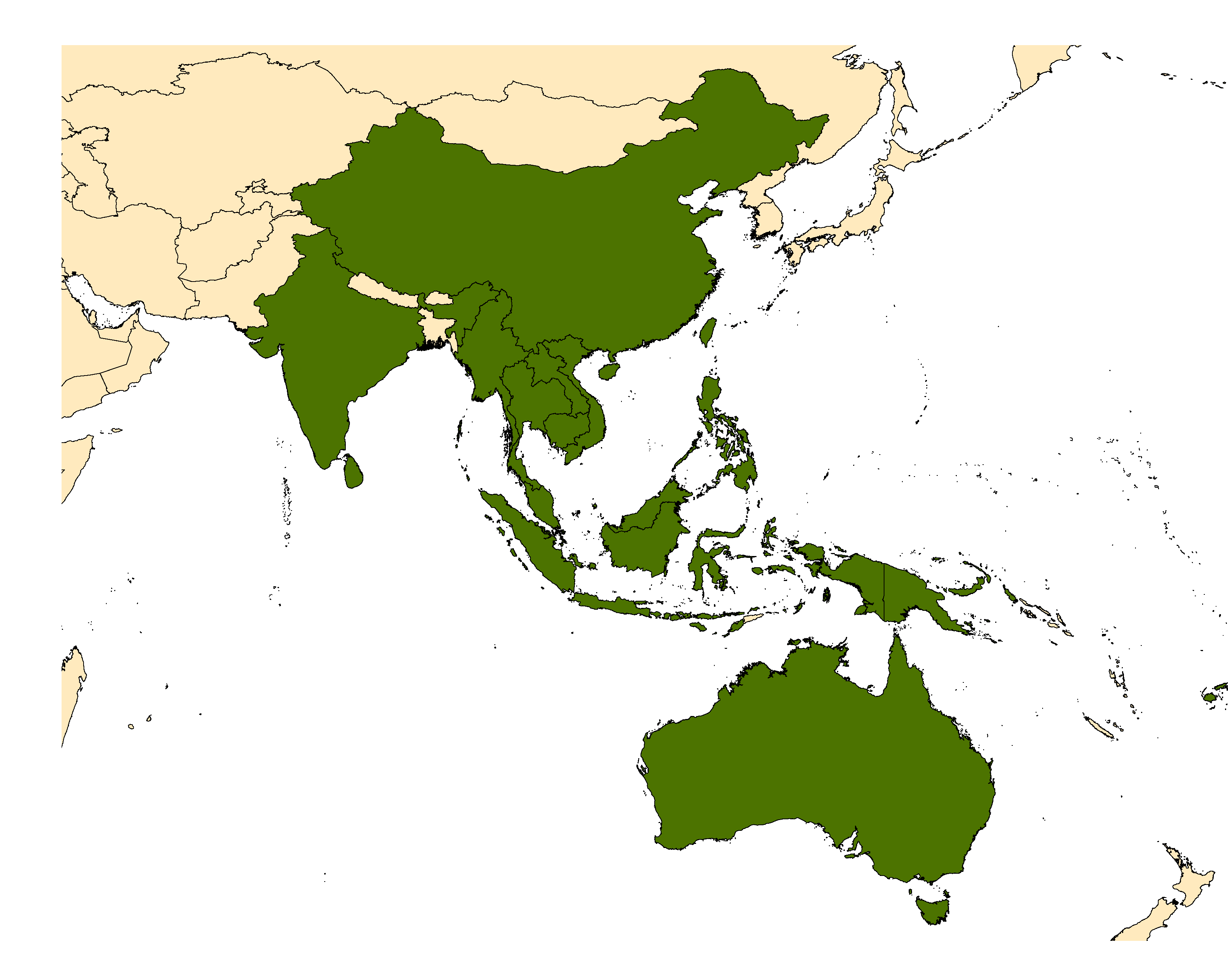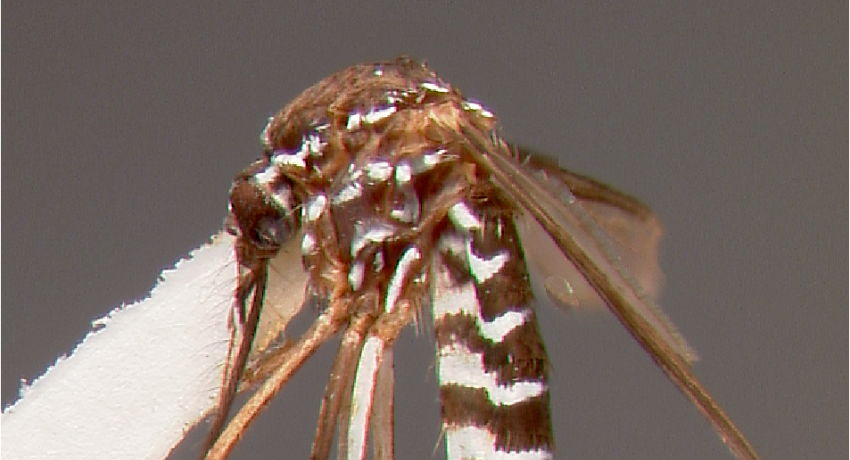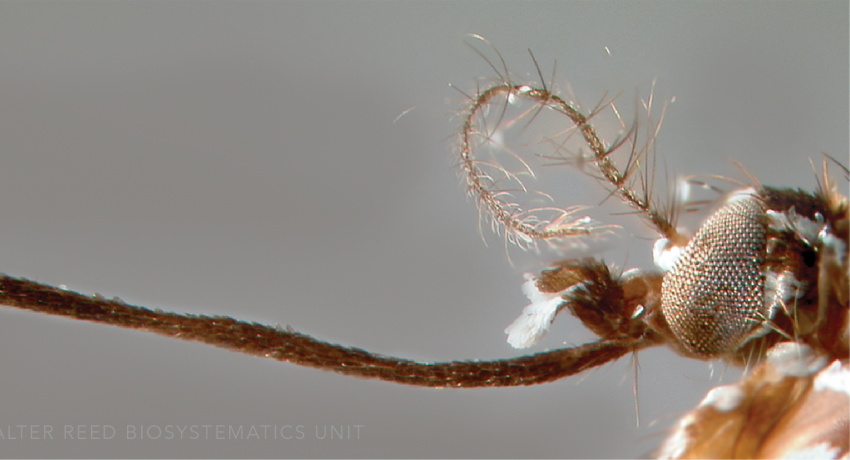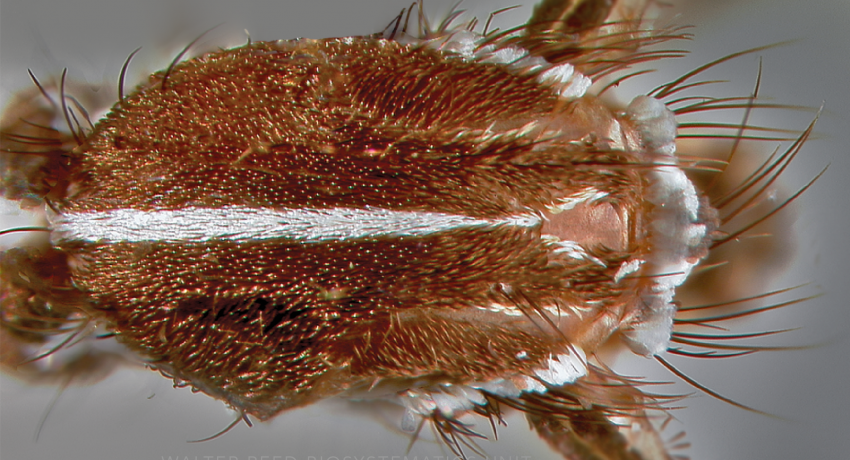AUSTRALASIAN & ORIENTAL REGIONS
Etymology: not stated
The legs, abdomen, and thorax of Ae. scutellaris are ornately decorated with thick rings and lines of silvery-white scales, giving it a decidedly striped appearance. It is the nominotypical member of the Scutellaris Group which comprises over 40 species including Aedes albopictus (Skuse), and is further subdivided into the Albopictus and Scutellaris Subgroups. All members of the Scutellaris Subgroup have well-developed supraalar white lines, with broad flat scales extending over the wing root towards the scutellum.
Type locality: Aroe Islands, [New Guinea]
Type depository: Natural History Museum, London, England, United Kingdom (NHMUK)
DIAGNOSTIC CHARACTERS (Click photos to view; mouse over and click large photo to zoom in.)
ADULT (illustrated): Head: Proboscis entirely dark-scaled; palpus with white scales at apex; pedicel with mesal and lateral scales. Thorax: Scutum with median silvery stripe; Lower proepisternal and lower mesepimeral scales white; paratergite with white scales; postpronotal scales present; subspiracular area with white scales; supraalar area with line of well-developed, broad white scales. Abdomen: Terga with complete or nearly complete pale bands. Legs: Fe-II without anterior median white line; Ta-I–VIII with basal pale bands.
LARVA (not illustrated): Head: Seta 1-A very small, weakly developed; seta 4-C prominent, many branched; seta 5-C single, about same level as 7-C; setae 4,6-C distinctly anterior to 7-C. Terminal segments: Comb scales in single row; CS spatulate, apex rounded but slightly narrowed apically, surrounded by short fringe; pecten with 10–16 spines; PS with 1–3 ventral and 1 or 2 small dorsal denticles; four pairs of seta 4-X; seta 1-S inserted at or before middle of siphon. Legs: Ta-III3 with basal 0.5 white; Ta-III4 with basal 0.75 white; Ta-III5 white-scaled.
TAXONOMIC KEYS
Lee et al. 1987a
![]()
WRBU – Aedes – Australasian Region – Larva
![]()
WRBU – Aedes – Indomalayan Region – Adult
![]()
WRBU – Aedes – Indomalayan Region – Larva
Exemplar DNA sequences
Ae. scutellaris COI: DQ397899, KP843372–401
BIONOMICS
Immatures
Female Ae. scutellaris preferentially oviposit in rough textured containers with low levels of reflected light, including in the crevices of coconut shells, tree holes, palm fronds, Pandanus leaf axils, bamboo, in discarded trash such as empty cans, and rarely, in small ground pools and wells. Immatures develop quickly—egg to imago in ˜7 days for males and ˜9 days for females.
Adults
Copulation in Aedes scutellaris takes place during flight and mating occurs close the host. Peak biting occurs in the evening, but female Ae. scutellaris will bite opportunistically during the day in shaded areas.
DISTRIBUTION NOTES
Admiralty Islands, Australia, Australia (Christmas Island or Kiritimati), Cambodia, Fiji, Guam, Hong Kong, India (includes Andaman Islands), Indonesia (Moluccas, Sumatra (includes Ketulauan Riouw Archipelago), West Papua), Malaysia, Mariana Islands, Micronesia (Wake Island), Myanmar, New Britain, New Hebrides, People’s Republic of China, Philippines, Sri Lanka, Taiwan, Tuvalu, Vanuatu.

WRBU VECTOR HAZARD REPORTS
None; View other WRBU Vector Hazard Reports
Available GIS Models
Ae_scutellaris_Nyari_1 Australasia
IMPORTANT REFERENCES (full citations below)
Walker 1859: 77 (F; Culex)
Buxton & Hopkins 1925 (E*, as synonym variegatus Doleschall, 1858)
Stone & Farner 1946 (Aedes scutellaris group)
Penn 1949b: 56 (P*)
Knight & Hull 1952: 180 (M*, F, L*)
Bonne-Wepster 1954: 79 (M, F*, L*)
Marks 1954: 383, pl. 18 (M*, F*)
Smith-White & Woodhill 1954: 163 (genetics)
Belkin 1962: 474 (M*, F)
Colless 1962: 313 (F*)
Mohrig 1967 (F*)
Huang 1970a (for 1969): 471 (M*; topotype)
Basio 1971b: 31 (M*; bionomics)
Huang 1972c: 55 (M*, F, P*, L*)
Lien et al. 1977 (distribution)
Lee et al. 1987a: 211 (F key, taxonomy bionomics, distribution, review)
Reinert 2000e: Fig. 38 (F*)
Kaur 2003: 452 (distribution; India)
CURRENT SYNONYMS
syn. variegatus Doleschall
1858: 77 (not Schrank, 1781) (A; Culex). Type locality: Amboina Island [Moluccas] (NE). References: Bonne-Wepster & Brug 1932: 83 (M*, F, L*; bionomics).
syn. zonatipes Walker
1861a: 229 (F; Culex). Type locality: Dorey, New Guinea (NHMUK). References: Bohart & Ingram 1946b: 26 (M*, F, L*; bionomics, distribution, taxonomy).
CURRENT SUBSPECIES
None
CITED REFERENCES
Basio, R. G. (1971b). The mosquito fauna of the Philippines (Diptera, Culicidae). Manila: National Museum of the Philippines. 198pp.
Belkin, J.N. (1962). The mosquitoes of the South Pacific (Diptera, Culicidae) (Vols. 1 & 2). Berkeley, California: University of California Press.
Bonne-Wepster, J. (1954). Synopsis of a hundred common non-anopheline mosquitoes of the Greater and Lesser Sundas, the Moluccas and New Guinea. Documenta de Medicina Geographica et Tropica, 6, 1–29.
Buxton, P.A., & Hopkins, G.H.E. (1925). The early stages of Somoan mosquitos [sic]. Bulletin of Entomological Research, 15, 167–170.
Colless, D.H. (1962). Notes on the taxonomy of the Aedes scutellaris group, and new records of A. paullusi and A. albopictus (Diptera: Culicidae). Proceedings of the Linnean Society of New South Wales, 87(3), 312–315.
Doleschall, C.L. (1858). Derde bijdrage tot de kennis der dipteren fauna van Neder landsch Indie. Natuurkundig Tijdschrift voor Nederlandsch Indie, 17, 73–128.
Huang, Y.-M. (1970c). The subgenus Stegomyia in Southeast Asia. Mosquito Systematics, 2(1), 6–8.
Huang, Y.-M. (1972c). Contributions to the mosquito fauna of Southeast Asia. XIV. The subgenus Stegomyia of Aedes in Southeast Asia. I. The Scutellaris group of species. Contributions of the American Entomological Institute, 9(1), 1–109.
Kaur, R. (2003). An update on the distribution of mosquitoes of the tribe Aedini in India (Diptera: Culicidae). Oriental Insects, 37, 439–455.
Knight, K.L., & Hull, W.B. (1952). The Aedes mosquitoes of the Philippine Islands II. Subgenera Skusea, Christophersiomyia, Geoskusea, Rhinoskusea, and Stegomyia (Diptera, Culicidae). Pacific Science, 6, 157–189.
Lee, D.J., Hicks, M.M., Griffiths, M., Debenham, M.L., Bryan, J.H., Russell, R.C., . . . Marks, E.N. (1987a). The Culicidae of the Australasian region. Volume 4. Commonwealth Department of Health, School of Public Health and Tropical Medicine Monograph Series, 2.
Lien, J.C., Kawengian, B.A., Partono, F., Lami, B., and Cross J.H. (1977). A brief survey of the mosquitoes of South Sulawesi, Indonesia, with special reference to the identity of Anopheles barbirostris (Diptera: Culicidae) from the Margolembo area. Journal of Medical Entomology, 13(6), 719–727.
Marks, E.N. (1954). A review of the Aedes scutellaris subgroup with A study of variation in Aedes pseudoscutellaris (Theobald) (Diptera: Culicidae). Bulletin of the British Museum (Natural History) (B), 3, 347–414.
Mohrig, W. (1967). Die taxonomische Bedeutung der Struktur weiblicher Genitalien im Culiciden- Tribus Aedini. Angewandte Parasitologie, 8, 67–100.
Penn, G.H. (1949b). The pupae of the mosquitoes of New Guinea. Pacific Science, 3, 3–85.
Reinert, J.F. (2000e). Comparative anatomy of the female genitalia of genera and subgenera in tribe Aedini (Diptera: Culicidae). Part V. Genus Aedes Meigen. Contributions of the American Entomological Institute, 32(3), 1–102.
Smith-White, S., & Woodhill, A.R. (1954). The nature and significance of nonreciprocal fertility in Aedes scutellaris and other mosquitoes. Proceedings of the Linnean Society of New South Wales, 79, 163–176.
Stone, A., & Farner, D.S. (1946). Further notes on the Aedes scutellaris group (Diptera, Culicidae). Proceedings of the Biological Society of Washington, 58, 155–162.
Walker, F. (1859). Catalogue of the dipterous insects collected at Makessar in Celebes, by Mr. A. R. Wallace, with descriptions of new species. Journal of the Proceedings of Linnean Society, Zoology, 4, 90–92.
Walker, F. (1861a). Catalogue of the dipterous insects collected at Dorey, New Guinea, by Mr. A. R. Wallace, with descriptions of new species. Journal of the Proceedings of the Linnean Society of London Zoology, 5, 229–254.
CITE THIS PAGE
Walter Reed Biosystematics Unit (Year). Aedes scutellaris species page. Walter Reed Biosystematics Unit Website, http://wrbu.si.edu/vectorspecies/mosquitoes/scutellaris, accessed on [date (e.g. 03 February 2020) when you last viewed the site].











































































































































































